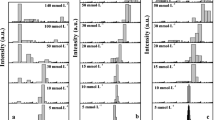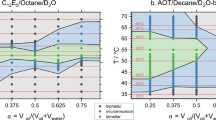Abstract
It has been confirmed that the structure of the alkyl group of an extended surfactant plays an important role in defining its interfacial properties. Alkyl groups containing a higher degree of β-branching (C2-branching) produce microemulsions with a larger characteristic length (ξ, the extent of solubilization in middle phases). This effect is explained on the basis that β-branching increases the hydrophobicity of the surfactant and decreases the optimal salinity of the microemulsion. Higher salinities produce a dehydration of the surfactant groups that lead to shorter extent of the interactions with the oil and the water. Larger characteristic lengths are desirable if the objective of the formulation is obtaining greater solubilization of oil and water, and lower interfacial tensions. Large characteristic lengths are, in most cases, associated with high interfacial rigidities, which are undesirable if rapid coalescence is required. However, mixtures of branched and linear extended surfactants produce large characteristic lengths and lower interfacial rigidities. The HLD-NAC model is able to reflect the experimental trends in solubilization of oil and water. The differences between the predictions of the model for the solubilization of oil and water in Type I and II formulations, respectively, highlight the complexities in the conformation of extended surfactants, particularly their PO groups, at oil–water interfaces and the need for advanced scattering techniques to evaluate these conformations.














Similar content being viewed by others

References
Miñana-Pérez M, Graciaa G, Lachaise J, Salager J-L (1995) Solubilization of polar oils with extended surfactants. Colloid Surf A 100:217–224
Phan TT, Harwell JH, Sabatini DA (2009) Effects of triglyceride molecular structure on optimum formulation of surfactant-oil-water systems. J Surf Deterg 13:189–194
Wu Y, Iglauer S, Shuler P, Tang Y, Goddard WA III (2010) Branched alkyl alcohol propoxylated sulfate surfactants for improved oil recovery. Tenside 47:152–161
Panswad D, Sabatini DA, Khaodhiar S (2011) Precipitation and micellar properties of novel mixed anionic extended surfactants and a cationic surfactant. J Surf Deterg 14:577–583
Shupe RD (1989) Process for secondary oil recovery utilizing propoxylated ethoxylated surfactants in sea water. US Patent 4,886,120, 12 Dec 1989
Gale WW et al. (1981) Propoxylated ethoxylated surfactant and method of recovering oil therewith. US Patent 4,293,428, 6 Oct 1981
Puerto MC (1986) Propoxylated surfactants for enhanced oil recovery in the range between high and low salinities. UK Patent Application GB 2168095A, 11 June 1986
Levitt DB et al. (2006) Identification and evaluation of high-performance EOR surfactants. 2006 SPE/DOE symposium on improved oil recovery, Tulsa, OK, SPE 100089
Wu Y, Shuler P, Blanco M, Tang Y, Goddard WA (2005) A study of branched alcohol propoxylate sulfate surfactants for improved oil recovery. 2005 SPE annual technical conference, Dallas, TX, SPE 95404
Kiran SM, Acosta EJ (2010) Predicting the morphology and viscosity of microemulsions using the HLD-NAC model. Ind Eng Chem Res 49:3424–3432
Acosta EJ, Bhakta AS (2008) The HLD-NAC model for mixtures of ionic and non-ionic surfactants. J Surf Deterg 12:7–19
Acosta E, Szekeres E, Sabatini DA, Harwell JH (2003) Net-average curvature model for solubilization and supersolubilization in surfactant microemulsions. Langmuir 19:186–195
Salager JL, Morgan J, Schechter RS, Wade WH, Vasquez E (1979) Optimum formulation of surfactant-oil-water systems for minimum tension and phase behavior. Soc Petrol Eng J 19:107–115
Salager JL, Márquez N, Graciaa A, Lachaise J (2000) Partitioning of ethoxylated octylphenol surfactants in microemulsion-oil-water systems: influence of temperature and relation between partitioning coefficient and physicochemical formulation. Langmuir 16:5534–5539
Acosta E, Yuan J, Bhakta A (2008) The characteristic curvature of ionic surfactants. J Surf Deterg 11:145–158
Hammond CE, Acosta E (2012) On the characteristic curvature of alkyl-polypropylene oxide sulfate extended surfactants. J Surf Deterg 15:157–165
Acosta E (2008) The HLD-NAC equation of state for microemulsions formulated with nonionic alcohol ethoxylate and alkylphenol ethoxylate surfactants. Colloids Surf A 320:193–204
Huh C (1979) Interfacial tensions and solubilizing ability of a microemulsion phase that coexists with oil and brine. J Colloid Interface Sci 71:408–426
Acosta EJ, Le MA, Harwell JH, Sabatini DA (2003) Coalescence and solubilization kinetics in linker-modified microemulsions and related systems. Langmuir 19:566–574
Witthayapanyanon A, Phan TT, Heitmann TC, Harwell JH, Sabatini DA (2010) Interfacial properties of extended-surfactant-based microemulsions and related macroemulsions. J Surf Deterg 13:127–134
Witthayapanyanon A, Harwell JH, Sabatini DA (2008) Hydrophilic-lipophilic deviation (HLD) method for characterizing conventional and extended surfactants. J Colloid Interface Sci 325:259–266
Rosen MJ (2004) Surfactants and interfacial phenomena, 3rd edn. Wiley, New York, p 55
Witthayapanyanon A, Acosta EJ, Harwell JH, Sabatini DA (2006) Formulation of ultralow interfacial tension systems using extended surfactants. J Surfactants Deterg 9:331–339
Klaus A, Tiddy GJT, Touraud D, Schramm A, Stühler G, Drechsler M, Kunz W (2010) Phase behavior of an extended surfactant in water and a detailed characterization of the dilute and semidilute phases. Langmuir 26:5435–5443
Velásquez J, Scorzza C, Vejar F, Forgiarini AM, Antón RE, Salager J-L (2010) Effect of temperature and other variables on the optimum formulation of anionic extended surfactant-alkane-brine systems. J Surfactants Deterg 13:69–73
Salager JL, Forgiarini A, Scorzza C, Tolosa L, Velasquez J (2010) Extended surfactants: a fine-tuned structure to improve interfacial performance through a gradual polarity transition. Oral presentation at the 101st American Oil Chemists Society, Phoenix, AZ, 17 May
Gompper G, Schick M (1990) Correlation between structural and interfacial properties of amphiphilic systems. Phys Rev Let 65:1116–1119
Kellay H, Binks BP, Hendrikx Y, Lee LT, Meunier J (1994) Properties of surfactant monolayers in relation to microemulsion phase behaviour. Adv Colloid Interface Sci 49:85–112
Bourrel M, Schechter R (1988) Microemulsions and related systems. Marcel Dekker, New York
Salager JL, Antón RE, Sabatini DA, Harwell JH, Acosta EJ, Tolosa LI (2005) Enhancing solubilization in microemulsions—state of the art and current trends. J Surf Deterg 8:3–21
De Gennes PG, Taupin C (1982) Microemulsions and the flexibility of oil/water interfaces. J Phys Chem 86:2294–2304
Forgiarini AM, Scorzza C, Velásquez J, Vejar F, Zambrano E, Salager J-L (2010) Influence of the mixed propoxy/ethoxy spacer arrangement order and of the ionic head group nature on the adsorption and aggregation of extended surfactants. J Surfactants Deterg 13:451–458
Author information
Authors and Affiliations
Corresponding author
About this article
Cite this article
Acosta, E.J., Kiran, S.K. & Hammond, C.E. The HLD-NAC Model for Extended Surfactant Microemulsions. J Surfact Deterg 15, 495–504 (2012). https://doi.org/10.1007/s11743-012-1343-2
Received:
Accepted:
Published:
Issue Date:
DOI: https://doi.org/10.1007/s11743-012-1343-2



